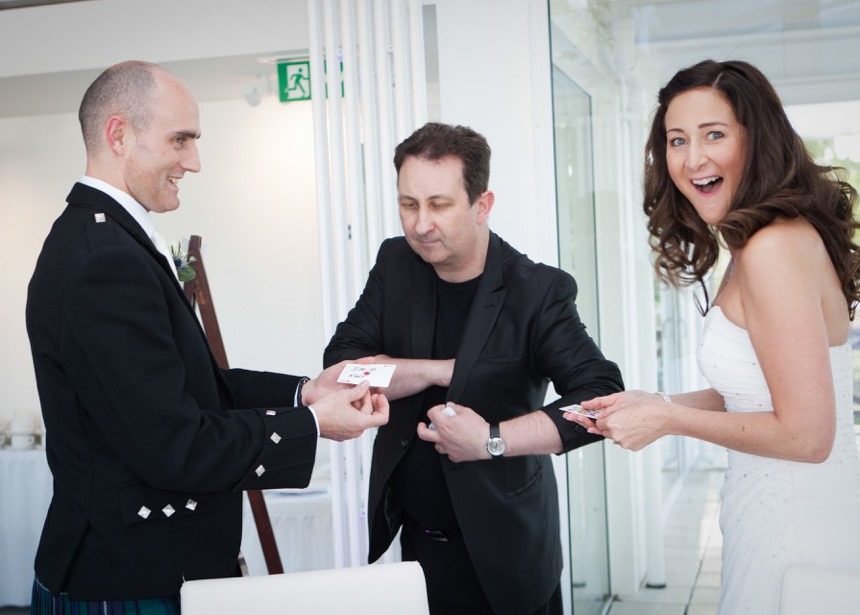
5 Common Mistakes Beginner Magicians Make (and How to Fix Them)


Andy Field is a professional magician, offering table top magic, sleight of hand illusions, mind reading and more, for a variety of occasions. Over the years Andy has built a strong global following, boasting over 5,000,000 views on his YouTube channel and an array of reviews across multiple platforms. Having amassed experience as a wedding magician, party magician & close up magician, Andy is seen as one of the industries most tried and tested professional magicians.
Exploring the world of magic for the first time can be incredibly exciting. Learning the secrets behind some of the most mind-blowing tricks and illusions is a thrill in itself, and performing them for friends, family and strangers is a buzz like no other.
However, as with everything, there’s a learning curve. Maybe you’ve found the perfect trick to amaze your peers, but despite how much you practice, you still can’t get it quite right. This can be very frustrating and, unfortunately, it’s why so many amateur magicians quit.
What if we told you there was a way to discover the top mistakes beginner magicians make and how to fix them? We’ve put together a guide that does just that.
After reading, private lessons can take your magical abilities to the next level. Ready to fast-track your skills and looking for magic lessons near me? Book a private lesson with Andy Field.
Mistake #1: Rushing Through the Trick
Number one on our list, and one of the most common mistakes we see beginner magicians making, is rushing through the trick as fast as they can. This can be all too easy to do for amateurs, and they often don’t even realise it’s happening until someone points it out.
Why does this happen? The biggest reason is nerves. Being nervous is totally normal, even the most experienced performers still feel those butterflies when they step onstage. However, while seasoned professionals understand how to manage these nerves, beginners let them dictate the pace of the performance. Another factor that can cause amateurs to rush through tricks is fear of someone noticing how it’s done. This speaks to a lack of confidence in the performer’s skills.
Rushing through tricks means missed opportunities to pause for dramatic effect. It can also leave the audience feeling bewildered, and sloppy, rushed reveals can minimise the impact and lose the mystery.
How can beginners avoid this pitfall? As always, practice is the key. Work on your timing and pacing. Slow-motion run throughs of your repertoire can be very useful. Ensuring you pause for two seconds before any reveal can help, too. Take the time to watch performances from the top professionals and pay close attention to how they pace their acts.
For deeper insights, check out Andy’s tutoring page to perfect your pacing and showmanship.
Mistake #2: Weak or Inconsistent Presentation
The tricks themselves are only part of what makes magic so exciting. The performance also plays an enormous role and has a major impact on audience enjoyment. Audiences want to be entertained, and they expect a level of engagement and participation from magicians.
Unfortunately, this important aspect is one that beginners often overlook. A lack of experience can see amateurs forget to engage the audience and focus only on the trick at hand. Conversely, some beginners might talk too much, which can overwhelm audiences and make performances unclear and difficult to follow.
A magic trick is a delicate balance of showmanship, storytelling and misdirection. This isn’t something you’ll be able to do overnight, it takes practice and study to perfect. Breaking down a trick into bullet points can help you stick to a structure that flows naturally. Identifying beats, or key micro-moments, in the routine can be very useful. You can use these as anchor points to match gestures or important sleight of hand moves.
Consistency in phrasing and language can also help maintain structure. You should also watch for audience reactions. Over time, you’ll be able to adapt your presentation to these reactions.
Not sure how to craft your patter? My 1–to–1 lessons can help you script each trick with clarity.
Mistake #3: Over-Reliance on Self-Working Tricks
Next up on our list of beginner magician mistakes is over-reliance on self-working tricks. These are usually the first tricks we learn as new magicians; they teach us the very basic building blocks of magic and are a fantastic entry point into the craft.
However, while these tricks are relatively easy to learn, they can be used as a crutch. Sticking to these tricks means you will struggle to evolve, and you may find yourself stuck in a rut with no progression in sight. You could develop a fear of learning more difficult moves, which will stunt your technical growth and leave your repertoire feeling stale and uninteresting.
Pushing and challenging yourself is the best way to ensure this doesn’t happen. You don’t need to dive straight into the most difficult tricks you can find. Start with foundational sleight skills, such as double lifts and false shuffles. Once you have these in your locker, you can start working them into more complex tricks.
Improving your technical skills won’t just give you more tricks to add to your routine, but it will also give you more confidence in your skills. This will shine through in your stage presence and will help take your performances to the next level.
Self-workers aren’t bad, but combine them with genuine sleight-of-hand to keep your shows dynamic.
Mistake #4: Neglecting Misdirection
Misdirection is the fundamental bedrock of any magic trick. Being able to control and manipulate your audience’s focus is the key to creating an illusion. While they’re focused on one thing, you’ll be setting up for the big reveal without them ever realising it.
One of the most common errors in magic performance is forgetting how important misdirection is. Neglecting it can be disastrous, and you run the risk of the audience spotting the secret behind the trick. This can ruin the entire performance and completely shatter the illusion you’ve worked so hard to craft.
Again, preparation is everything when it comes to perfecting the art of misdirection. Think carefully about your routine and identity key points where you could successfully misdirect the audience. Everything from body posture and eye contact to scripted lines and props can be used to create a distraction. Practice with a friend and ask them to watch your hands closely. If you can successfully distract them at the key moment, you’ll know that you’re on the right track.
Misdirection is an art form in itself. Mastering it is the key to improving your magic tricks and amazing audiences. Book a workshop for a hands-on approach to misdirection tactics.
Mistake #5: Lack of Feedback & Reflection
Mastering the art of magic is a lifelong learning process. While responsibility for your progression ultimately lies with you, failing to take on feedback and reflect on audience responses is one of the most common mistakes learning magic.
It’s easy to understand why this happens. Criticism can be difficult to take, especially after you’ve worked so hard in practice. This can cause beginner magicians to draw inwards and develop a fear of public performance, preferring to stick to amazing their bedroom mirror rather than real people.
However, without real feedback, you could find yourself repeating the same mistakes over and over again, whether that’s sloppy, unpolished transitions or weak, awkward reveals. And critically, you’re never going to learn from these mistakes without an audience response.
A Performance Journal can help you track feedback and accelerate your development. After each performance, make a note of what went wrong and what went right and use this to guide your practice moving forward. You can also record your performances to give you a reference to look back on.
Don’t overlook the community aspect, either. Working with other magicians can be a fantastic way of learning. Find a magic club or an online group for honest critiques, or get professional feedback in a 1-on-1 session.
Conclusion & CTA
Magician tips for beginners often focus on new things to learn. With this guide, we’ve outlined the most important things to avoid doing. Understanding how to get better at magic tricks involves familiarising yourself with some of the most common beginner pitfalls.
Rushing through the trick: Practice your timing and pacing and leave a two-second pause before the reveal.
Weak or inconsistent presentation: Break down your trick into bullet points and identify beats/key moments to build an entertaining narrative.
Overreliance on self-working tricks: Learn foundational sleight skills and use them to learn more complex tricks and routines.
Neglecting misdirection: Identify key misdirection opportunities in your routine and practice with friends to master the art of distraction.
Lack of feedback and reflection: Keep a Performance Journal to track your performances and identify areas for improvement.
Always remember that every slip-up is a stepping stone; with the right guidance, you’ll be mesmerizing audiences sooner than you think.
Turn mistakes into mastery—book a private lesson and see real improvement fast!
MAKE AN ENQUIRY
Oops! We could not locate your form.




